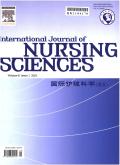Prevalence of workplace violence against nurses in Saudi Arabia: A systematic review and meta-analysis
IF 3.1
3区 医学
Q1 NURSING
引用次数: 0
Abstract
Objectives
Workplace violence is a serious issue in healthcare settings. Nurses are particularly vulnerable, and such violence significantly impacts their professional lives, leading to decreased productivity and care quality. We aimed to estimate the pooled prevalence of workplace violence against nurses through systematic review and meta-analysis in Saudi Arabia.
Methods
Databases were searched for articles published in English from 2013 to 2023, including PubMed, Web of Science, Science Direct, Medline, Emerald, Wiley, and ProQuest. The quality of the included studies was rigorously assessed using the Joanna Briggs Institute (JBI) critical appraisal tools. Meta-analysis was conducted using Comprehensive Meta-Analysis software. Subgroup analysis, meta-regression, and publication bias tests were performed.
Results
The pooled prevalence of workplace violence among nurses in Saudi Arabia was 61.8 % (95 %CI: 45.8 %–75.6 %). Subgroup analysis showed the highest prevalence of workplace violence in studies conducted before 2020 at 69.7 % (95 %CI: 42.0 %–88.0 %) and 2020-2023 at 57.0% (95 %CI: 35.6 %–76.1 %); in the western region at 90.2 % (95 %CI: 70.2 %–97.3 %); among female nurses at 81.8 % (95 %CI: 66.9 %–90.9 %); with patient relatives as perpetrators at 70.8 % (95 %CI: 46.4 %–87.2 %); during afternoon shifts at 78.5 % (95 %CI: 64.4 %–88.1 %); for verbal abuse at 54.9 % (95 %CI: 31.3 %–76.6 %); and in the intensive care unit at 68.1 % (95 %CI: 28.1 %–92.1 %). Meta-regression analysis revealed that the night shift significantly contributed to heterogeneity. The funnel plot and Egger’s regression test (P = 0.647) indicated no significant publication bias.
Conclusions
This meta-analysis showed the estimate of workplace violence against nurses in Saudi Arabia is 61.8 %. Nursing managers and health policymakers should implement targeted interventions to prevent workplace violence, especially among female nurses, during afternoon shifts, in intensive care units, and in the western region of Saudi Arabia.
沙特阿拉伯对护士的工作场所暴力的普遍性:系统回顾和荟萃分析
工作场所暴力是医疗机构中的一个严重问题。护士尤其脆弱,这种暴力严重影响了她们的职业生活,导致生产力和护理质量下降。我们旨在通过系统回顾和荟萃分析来估计沙特阿拉伯针对护士的工作场所暴力的总体发生率。方法检索PubMed、Web of Science、Science Direct、Medline、Emerald、Wiley、ProQuest等数据库2013 - 2023年发表的英文论文。使用乔安娜布里格斯研究所(JBI)关键评估工具严格评估纳入研究的质量。采用综合meta分析软件进行meta分析。进行亚组分析、meta回归和发表偏倚检验。结果沙特阿拉伯护士工作场所暴力总发生率为61.8% (95% CI: 45.8% ~ 75.6%)。亚组分析显示,在2020年之前进行的研究中,工作场所暴力的发生率最高,为69.7% (95% CI: 42.0% - 88.0%), 2020-2023年为57.0% (95% CI: 35.6% - 76.1%);西部地区为90.2% (95% CI: 70.2% - 97.3%);女护士占81.8% (95% CI: 66.9% - 90.9%);患者亲属为肇事者占70.8% (95% CI: 46.4% - 87.2%);下午班为78.5%(95%置信区间:64.4% - 88.1%);言语虐待占54.9% (95% CI: 31.3% - 76.6%);重症监护病房为68.1% (95% CI: 28.1% - 92.1%)。元回归分析显示,夜班对异质性有显著影响。漏斗图和Egger回归检验(P = 0.647)显示无显著发表偏倚。本荟萃分析显示,在沙特阿拉伯,针对护士的工作场所暴力估计为61.8%。护理管理人员和卫生政策制定者应实施有针对性的干预措施,以防止工作场所暴力,特别是在女护士、下午班、重症监护病房和沙特阿拉伯西部地区。
本文章由计算机程序翻译,如有差异,请以英文原文为准。
求助全文
约1分钟内获得全文
求助全文
来源期刊

International Journal of Nursing Sciences
Nursing-Nursing (all)
CiteScore
6.10
自引率
2.60%
发文量
408
审稿时长
25 days
期刊介绍:
This journal aims to promote excellence in nursing and health care through the dissemination of the latest, evidence-based, peer-reviewed clinical information and original research, providing an international platform for exchanging knowledge, research findings and nursing practice experience. This journal covers a wide range of nursing topics such as advanced nursing practice, bio-psychosocial issues related to health, cultural perspectives, lifestyle change as a component of health promotion, chronic disease, including end-of-life care, family care giving. IJNSS publishes four issues per year in Jan/Apr/Jul/Oct. IJNSS intended readership includes practicing nurses in all spheres and at all levels who are committed to advancing practice and professional development on the basis of new knowledge and evidence; managers and senior members of the nursing; nurse educators and nursing students etc. IJNSS seeks to enrich insight into clinical need and the implications for nursing intervention and models of service delivery. Contributions are welcomed from other health professions on issues that have a direct impact on nursing practice.
 求助内容:
求助内容: 应助结果提醒方式:
应助结果提醒方式:


